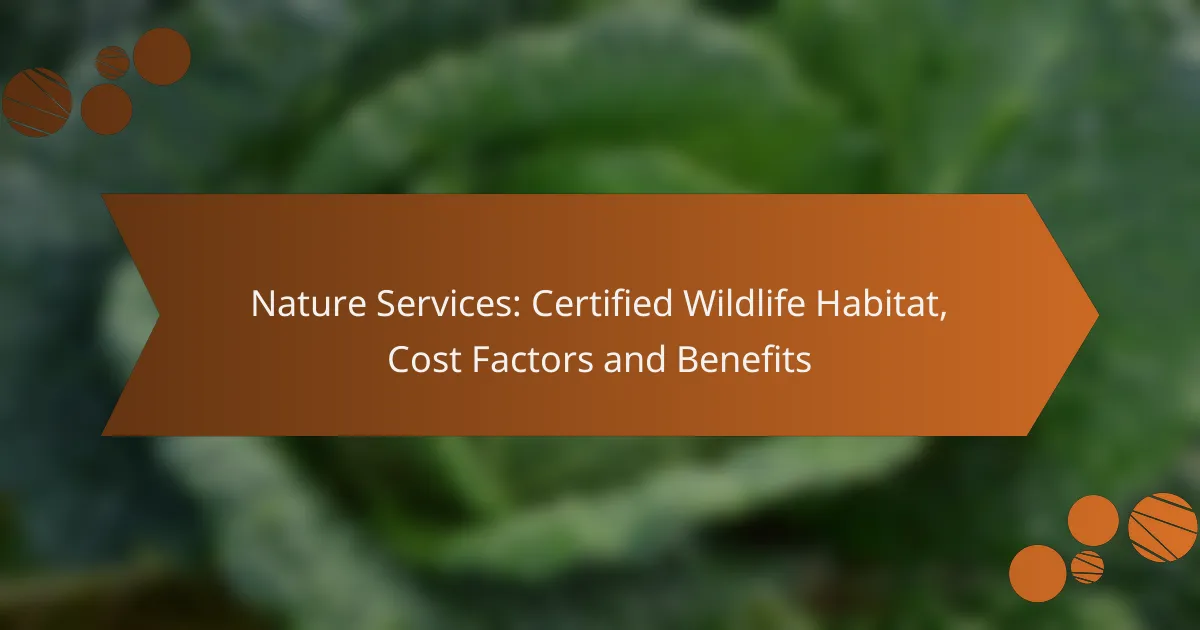Creating a certified wildlife habitat offers significant benefits, such as enhanced biodiversity and improved ecosystem health, while also increasing property value and fostering community engagement. In California, the costs associated with establishing these habitats can vary widely, influenced by factors like size, complexity, and maintenance needs. By focusing on essential elements for wildlife, such as food, water, and shelter, property owners can contribute to a healthier urban environment.

What are the benefits of certified wildlife habitats in Los Angeles?
Certified wildlife habitats in Los Angeles provide numerous advantages, including enhanced biodiversity, improved ecosystem health, increased property value, and opportunities for community engagement. These habitats support local wildlife and contribute to a healthier urban environment.
Enhanced biodiversity
Creating certified wildlife habitats promotes enhanced biodiversity by providing essential resources such as food, water, and shelter for various species. In Los Angeles, this can include native plants that attract pollinators like bees and butterflies, as well as birds and small mammals. Homeowners can contribute to local ecosystems by incorporating diverse plant species into their gardens.
To maximize biodiversity, consider planting a mix of native flora that bloom at different times throughout the year. This approach ensures that wildlife has access to resources across seasons, fostering a vibrant and resilient ecosystem.
Improved ecosystem health
Certified wildlife habitats contribute to improved ecosystem health by promoting natural processes such as pollination, seed dispersal, and pest control. These habitats can help mitigate urban heat effects and improve air quality by increasing green spaces in the city. In Los Angeles, where urbanization is prevalent, these benefits are particularly significant.
To enhance ecosystem health, maintain a balanced habitat by avoiding chemical pesticides and fertilizers, which can harm beneficial insects and soil health. Instead, consider organic gardening practices that support a thriving ecosystem.
Increased property value
Investing in a certified wildlife habitat can lead to increased property value in Los Angeles. Properties with well-maintained gardens that support wildlife often attract buyers who value sustainability and environmental stewardship. A beautiful, biodiverse landscape can enhance curb appeal and set a home apart in a competitive real estate market.
Homeowners can further increase property value by incorporating features like native gardens, rain gardens, or bird-friendly designs. These elements not only appeal to potential buyers but also contribute positively to the local environment.
Community engagement opportunities
Certified wildlife habitats offer numerous community engagement opportunities, fostering connections among neighbors and promoting environmental awareness. Residents can collaborate on habitat restoration projects, organize workshops on native gardening, or participate in local wildlife monitoring efforts. These activities strengthen community bonds and encourage collective action towards sustainability.
To get involved, consider joining local environmental groups or attending community events focused on wildlife conservation. Engaging with others who share similar interests can lead to meaningful partnerships and a greater impact on local ecosystems.

How much do certified wildlife habitats cost in California?
Certified wildlife habitats in California can vary significantly in cost, typically ranging from a few hundred to several thousand dollars depending on the size and complexity of the habitat. Factors influencing these costs include initial setup, ongoing maintenance, and any potential tax incentives available to property owners.
Initial setup costs
The initial setup costs for creating a certified wildlife habitat in California can range from approximately $500 to $5,000. This includes expenses for native plants, soil amendments, water features, and other habitat elements. Homeowners should consider their specific goals, such as attracting certain wildlife species, which can influence the overall investment.
To minimize costs, consider starting small and gradually expanding the habitat. Utilizing local resources, such as community plant swaps or native plant nurseries, can also help reduce expenses.
Ongoing maintenance expenses
Ongoing maintenance expenses for certified wildlife habitats can vary, typically falling between $100 and $1,000 annually. This includes costs for watering, weeding, mulching, and replacing plants as needed. Regular maintenance is essential to ensure the habitat remains inviting for wildlife and continues to thrive.
Homeowners can reduce maintenance costs by selecting drought-resistant plants and implementing sustainable practices, such as composting and using organic pest control methods.
Potential tax incentives
California offers potential tax incentives for property owners who create certified wildlife habitats, which can help offset some costs. These incentives may include property tax reductions or credits for conservation efforts. It is advisable to consult with a tax professional or local government office to understand the specific benefits available.
Additionally, participating in local conservation programs or initiatives may provide further financial assistance or grants to support habitat creation and maintenance efforts.

What steps are involved in creating a certified wildlife habitat?
Creating a certified wildlife habitat involves a series of steps that focus on providing essential elements for wildlife, such as food, water, shelter, and places for wildlife to raise their young. The process requires careful planning and consideration of local conditions and native species.
Assessing site conditions
Begin by evaluating the specific conditions of your site, including soil type, sunlight exposure, and existing vegetation. Understanding these factors will help you determine which native plants and features will thrive in your habitat.
Consider conducting a soil test to check for pH and nutrient levels, as this can influence plant selection. Additionally, observe the local climate and seasonal changes to ensure your habitat remains viable year-round.
Choosing native plants
Selecting native plants is crucial for attracting local wildlife and ensuring ecological balance. Native species are adapted to the local environment, require less maintenance, and provide food and shelter for native animals.
Research local flora to find plants that suit your site conditions and support local wildlife. Aim for a mix of flowering plants, shrubs, and trees to create diverse habitats. Resources like local nurseries or conservation organizations can provide guidance on suitable native plants.
Implementing water features
Water features, such as ponds, birdbaths, or rain gardens, are vital for attracting wildlife and supporting biodiversity. These features provide essential hydration and create habitats for aquatic species.
When designing water features, consider their size and placement to maximize their ecological benefits. Ensure that water sources are clean and safe for wildlife. Regular maintenance is necessary to prevent stagnation and maintain water quality.

What criteria must be met for certification in the National Wildlife Federation program?
To achieve certification in the National Wildlife Federation program, a habitat must provide essential elements for wildlife, including food sources, shelter, and water availability. Meeting these criteria demonstrates a commitment to supporting local ecosystems and biodiversity.
Providing food sources
Providing food sources is crucial for attracting and sustaining wildlife in your habitat. This can include native plants that produce seeds, fruits, and nectar, which are essential for birds, butterflies, and other pollinators. Consider incorporating a variety of plants that bloom at different times to ensure year-round food availability.
Additionally, you can supplement natural food sources with bird feeders or native plant gardens. For example, sunflower seeds or thistle can attract various bird species, enhancing the diversity of wildlife in your area.
Creating shelter
Creating shelter is vital for wildlife to find protection from predators and harsh weather. This can be achieved through dense shrubs, native trees, or even constructed habitats like birdhouses and bat boxes. Each type of shelter serves different species, so consider the needs of local wildlife when designing your space.
Incorporating features such as brush piles or rock piles can also provide refuge for smaller animals and insects. Aim for a mix of open and sheltered areas to cater to various wildlife preferences.
Ensuring water availability
Ensuring water availability is essential for wildlife survival. This can be accomplished by installing bird baths, small ponds, or rain gardens that collect and filter rainwater. These features not only provide drinking water but also create habitats for amphibians and beneficial insects.
When designing water features, consider their size and depth to accommodate different species. Shallow areas are ideal for birds, while deeper sections can support aquatic life. Regular maintenance, such as cleaning and refilling, will help keep these water sources attractive to wildlife.

What are the local regulations for wildlife habitats in urban areas?
Local regulations for wildlife habitats in urban areas typically focus on zoning laws, permitting requirements, and environmental impact assessments. These regulations aim to balance urban development with the preservation of natural ecosystems, ensuring that wildlife habitats are protected and maintained.
Zoning laws
Zoning laws dictate how land can be used in urban areas, affecting where wildlife habitats can be established. These laws may designate certain zones for residential, commercial, or conservation purposes, which can limit habitat creation in densely populated regions. It’s essential to check local zoning ordinances to understand what types of habitats are permissible in specific areas.
For example, some cities may have designated green spaces or conservation zones where wildlife habitats are encouraged, while others may restrict such activities to prevent conflicts with urban development.
Permitting requirements
Establishing a wildlife habitat often requires obtaining various permits from local authorities. These permits ensure that the habitat complies with local regulations and does not negatively impact surrounding areas. The process may involve submitting plans that detail the intended habitat design, maintenance practices, and potential impacts on local wildlife.
In many cases, applicants may need to demonstrate how the habitat will benefit local ecosystems or contribute to biodiversity. It’s advisable to consult with local environmental agencies to understand specific permitting processes and timelines.
Environmental impact assessments
Environmental impact assessments (EIAs) evaluate the potential effects of a proposed wildlife habitat on the surrounding environment. These assessments are crucial for identifying any negative impacts on local ecosystems and ensuring compliance with environmental regulations. Depending on the location and scale of the habitat, an EIA may be required before permits are issued.
Conducting an EIA typically involves gathering data on local wildlife, vegetation, and water sources, as well as proposing mitigation strategies for any identified risks. Engaging with environmental consultants can help streamline this process and ensure thorough evaluations are conducted.

How can community members get involved in wildlife habitat initiatives?
Community members can engage in wildlife habitat initiatives by participating in local conservation programs, volunteering for habitat restoration projects, and advocating for wildlife-friendly policies. These actions help to create and maintain certified wildlife habitats that support biodiversity and promote ecological health.
Understanding Certified Wildlife Habitats
Certified wildlife habitats are areas that provide essential resources for local wildlife, including food, water, shelter, and places for breeding. To achieve certification, habitats must meet specific criteria set by organizations like the National Wildlife Federation. This process often involves creating a plan that incorporates native plants and sustainable practices.
Cost Factors for Creating Wildlife Habitats
The costs associated with establishing a certified wildlife habitat can vary widely based on size, location, and existing conditions. Initial expenses may include purchasing native plants, installing water features, or creating shelter structures. Budgeting for ongoing maintenance is also crucial, as habitats require care to remain functional and beneficial for wildlife.
Benefits of Wildlife Habitats
Creating certified wildlife habitats offers numerous benefits, both ecological and social. These areas enhance local biodiversity, support pollinators, and improve soil and water quality. Additionally, they provide educational opportunities for communities and can increase property values by enhancing the natural landscape.
